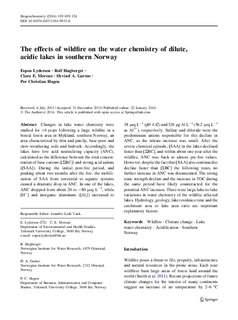| dc.contributor.author | Lydersen, Espen | |
| dc.contributor.author | Høgberget, Rolf | |
| dc.contributor.author | Vicente, Clara E. Moreno | |
| dc.contributor.author | Garmo, Øyvind Aaberg | |
| dc.contributor.author | Hagen, Per Christian | |
| dc.date.accessioned | 2014-08-06T12:30:07Z | |
| dc.date.accessioned | 2014-08-13T11:13:50Z | |
| dc.date.available | 2014-08-06T12:30:07Z | |
| dc.date.available | 2014-08-13T11:13:50Z | |
| dc.date.issued | 2014 | |
| dc.identifier.citation | Lydersen, E., Høgberget, R., Moreno, C., Garmo, Ø., Hagen, P., 2014. The effects of wildfire on the water chemistry of dilute, acidic lakes in southern Norway. Biogeochemistry 119(1-3) 109-124. | nb_NO |
| dc.identifier.issn | 0168-2563 | |
| dc.identifier.uri | http://hdl.handle.net/11250/217132 | |
| dc.description.abstract | Changes in lake water chemistry were studied for >4 years following a large wildfire in a boreal forest area in Mykland, southern Norway, an area characterized by thin and patchy, base-poor and slow-weathering soils and bedrock. Accordingly, the lakes have low acid neutralizing capacity (ANC), calculated as the difference between the total concentration of base cations ([ΣBC]) and strong acid anions ([SAA]). During the initial post-fire period, and peaking about two months after the fire, the mobilization of SAA from terrestrial to aquatic systems caused a dramatic drop in ANC. In one of the lakes, ANC dropped from about 20 to −80 μeq L−1, while [H+] and inorganic aluminum ([Ali]) increased to 38 μeq L−1 (pH 4.42) and 326 μg Al L−1 (36.2 μeq L−1 as Al3+), respectively. Sulfate and chloride were the predominant anions responsible for this decline in ANC, as the nitrate increase was small. After the severe chemical episode, [SAA] in the lakes declined faster than [ΣBC], and within about one year after the wildfire, ANC was back to almost pre-fire values. However, despite the fact that [SAA] also continued to decline faster than [ΣBC] the following years, no further increase in ANC was documented. The strong ionic strength decline and the increase in TOC during the same period have likely counteracted for the potential ANC increase. There were large lake-to-lake variations in water chemistry of the wildfire affected lakes. Hydrology, geology, lake residence time and the catchment area to lake area ratio are important explanatory factors. | nb_NO |
| dc.language.iso | eng | nb_NO |
| dc.publisher | Springer | nb_NO |
| dc.relation.uri | http://link.springer.com/article/10.1007%2Fs10533-014-9951-8 | |
| dc.rights | Navngivelse 4.0 Internasjonal (CC BY 4.0) | * |
| dc.rights | http://www.springer.com/gp/open-access/springer-open-choice | |
| dc.rights.uri | https://creativecommons.org/licenses/by/4.0/deed.no | * |
| dc.title | The effects of wildfire on the water chemistry of dilute, acidic lakes in southern Norway | nb_NO |
| dc.type | Journal article | nb_NO |
| dc.type | Peer reviewed | nb_NO |
| dc.date.updated | 2014-08-06T12:30:08Z | |
| dc.rights.holder | The authors | |
| dc.identifier.doi | 10.1007/s10533-014-9951-8 | |
| dc.identifier.cristin | 1126599 | |

